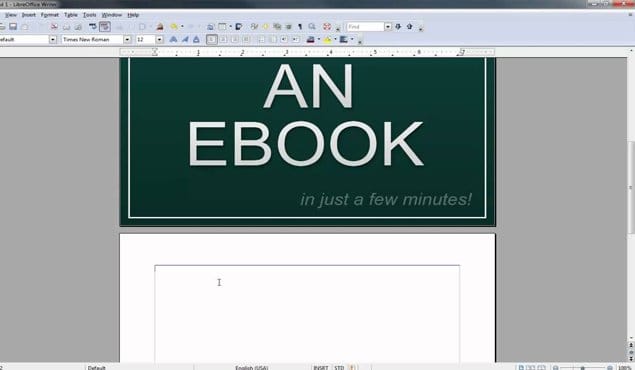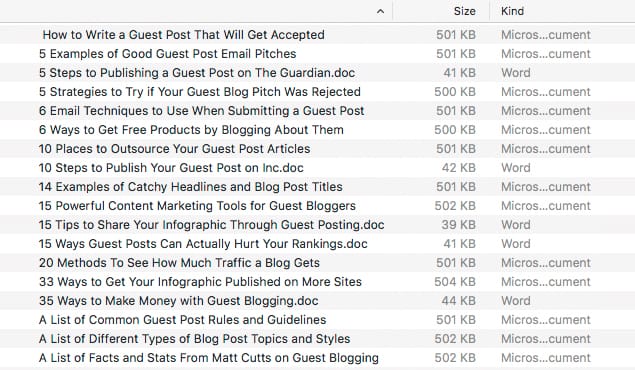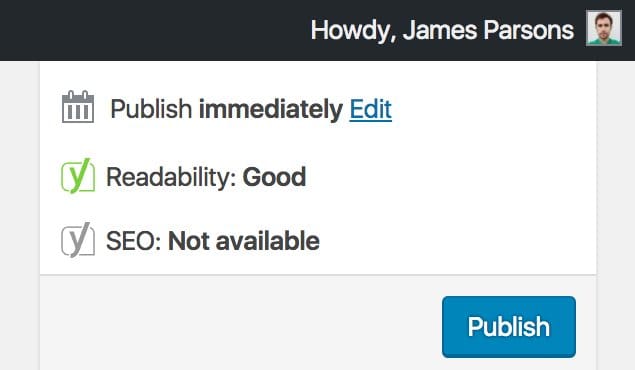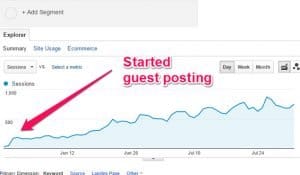Guest posting does not have to be an expensive task. In fact, if you approach it using the right technique, you can get a ton of posts throughout your industry for a relatively small investment of time and energy. Here’s one such process I’ve put to use for great success.
Step 1: Create a Flagship eBook
The first thing you need to do in order to get widespread guest posts is create something central to them all. I chose an eBook for two reasons. Firstly, it’s something packed with value, beyond what even a high level blog post can achieve. Secondly, it’s something that can bring in a lot of value on its own, either through sales via Amazon or through email harvesting via a landing page.
You don’t have to use an eBook for this. You can launch a new product or service, you can launch a new massive guide akin to the Moz SEO guide or the QuickSprout online marketing guide. You’ll notice that the core feature of all of them is something large, valuable, and worth obtaining.
You will be using this as the core value for your entire campaign, so you need to make sure it’s good, and I mean really good. This will carry you for at least six months, so take the time to invest in it. Hire a great writer if you need to, or some good developers, or good graphic designers. This is going to be a top-tier piece of content.
Step 2: Create Excellent Site Content
The next step is to build up a small library of excellent content to publish on your site. I recommend a three-phase content scheme.
Phase one of the content scheme is content that teases what you’re producing without giving away the value. This is content that mentions you’re “working on something big” or “producing a top-tier guide about X.” You want this to drum up interest, and get people watching for when it’s published. You will start publishing these now. Each blog post you write about this should be at least slightly related to the content you’re publishing later.
Phase two of the content scheme is content that will be published around the same time as the actual publication of the flagship book. It will be aimed at getting people to download, getting people to understand the value of what you’re offering, and used as landing blog posts for the guest posts you write later. These will be published anywhere from two weeks before launch to a month after launch.
Phase three of the content scheme is all of the content you publish afterwards, and isn’t really something you can write ahead of time. It’s more of a reminder that you need to keep mentioning the content you produced. It’s also time for you to mention and link back to the people who accepted your guest posts, to give them some value in return.
Step 3: Build a List of Potential Publications
Before you’ve published anything except for a couple of teaser posts in phase one of your content plan, you should build up a list of every possible site in your industry that you would like to have a guest post on. Some of them, if you’ve been at it for a while, will already have published you in the past. Some will be new, some will have rejected you before, and some are “hail mary” attempts that aren’t likely to work. It doesn’t matter: just make the list, or adapt the list you already have if you’ve followed my processes before.
You want to avoid the sites that are very low quality and unlikely to send you any value. You’re looking for broad-scale representation of your brand and awareness of your upcoming content. Also, keep in mind that the sites definitely need to be in your industry; you want to attract people with your new eBook, and you can’t do that with off-industry publications.
Step 4: Send a Press Release to Potential Publications
Before you start drafting up your pitches for your guest post opportunities, you want to send out a broader, general press release to them about the fact that you’re producing this high quality guide. The idea is not to get them to publish the press release – in fact, explicitly tell them you don’t want them to do so. The goal is awareness; letting them know something big is coming down the pipe, something they might be interested in covering.
A few of the sites you send this press release to will ask you for more information or for an interview. In these cases, that’s great! You can ignore sending a guest post pitch and simply do their interview. It’s just as good, if not better, because it’s direct promotion of you without needing to be the one publishing it.
For the sites that don’t respond, keep them on the list for guest post pitches.
Step 5: Pitch Relevant Topical Guest Posts, Unique to Each Publication
Now comes the most time-consuming and tedious part of the whole thing. You need to send out your mass guest post solicitations, but you can’t do it in a way that actually is mass-produced.
Start off with a lead-up about how you send out a press release about your flagship book, and that you’d like to get some further awareness of it. Since the book covers topic X – chosen on a per-site basis related to the primary topic of that site – you would like to write an authoritative post for their site covering <similar, smaller version of the topic>. This is where you create your unique pitch. You want something the site is more likely to be interested in publishing.
Explain that the only promotion of the book you intend to do is in the author bio. This helps the site recognize that you’re offering value in the content, not just basic content for a link.
You’re going to have to do a lot of individual work here. Leverage connections you have. Link to similar content as an example of what you can do, particularly some of your more recent content scheme top-tier content. Make sure to put your best foot forward.
Step 6: For Accepted Pitches, Request Specific Publication Dates
Now comes the tricky part, where you have to manage potentially dozens of lines of correspondence simultaneously, produce a ton of unique and valuable content, and manage scheduling with as many sites as you’re able to work with.
The ideal here is to get all of your guest posts published around the same time. This will be either just before, during, or just after the publication of your flagship book. You want as much traffic leading to it as possible.
Some sites will be happy to let you specify when you want the content published. Others won’t, or will work it into their own content schedule regardless of when you would like it to be published. This is okay; the outliers help keep your post alive longer than it would otherwise live.
Go through the usual process of pitching specific guest post ideas, refining them with the editors of the publications you target, writing them, and submitting them. If you need to have a high quality ghost writer create the content, you can do so, but make sure you go over every piece of content with a fine-toothed comb to make sure it’s something you’re proud to have your name attached to. You want exceptional content to showcase your brand and represent your quality across the web.
This part of the process might cost money, if you need to pay writers, but it all depends on how you do it. The only thing I recommend is to avoid any site that charges for their guest post slots. You don’t want to be found exchanging money for links, nor will their user base likely be valuable to you.
Step 7: Publish Everything
The day arrives, and it’s time for the blitz. Ideally, a lot of guest posts will go up on this day. Your eBook should also be live and available for sale on this date. Generally, Amazon is pretty good about getting your content published when you specify, it’s only when you have an issue that they might delay it.
Publish your blog posts at the same time, as well as any other forms of marketing you want to use. An infographic can go a long way if you want to dig into infographic marketing at the same time as the rest of this. That’s a separate endeavor, though, so I might recommend waiting a few cycles until you’re comfortable with this process first.
Step 8: Support Posts After Publication
Don’t forget your social media promotion. You want to promote every aspect of this throughout the weeks and months following the big day.
- Post on social media to promote the blog posts that are, themselves, promoting your major eBook.
- Post on social media, both organically and via paid ads, to promote your eBook itself. This is the only actual monetary expense I consider mandatory. It’s your flagship content; you should be getting a positive return on your investment with paid advertising.
- Post on social media throughout the week following release to directly @mention and promote the people who have done the most to promote your eBook. Mentioning these people gives them more recognition with your audience. These will be the biggest sites that accepted your guest posts or that have covered your book in interviews.
- Post on social media throughout the following month or so, linking to the people who have published your guest posts. I like to set up a value-based promotion system. The best sites, the ones that refer the most traffic and do the most to help promote you, get anywhere from 3-5 mentions throughout the following month, and semi-regular links in my content afterwards. Lower quality promoters will get 1-2 links in my social feeds throughout the following month, and maybe the occasional link in content. Other less valuable guest posts will get one mention, and maybe a link in content if I’m feeling generous, but they will typically be lower priority.
Any support you can give to your book, your posts, and your guest posts will help compound the value they all give you in this system.
Step 9: Repeat
The core component of any strategy like this is to repeat your success. Measure what has happened throughout the process. Look for elements you can streamline. Did some freelancers not pull their weight? Could you do some more work yourself, or outsource more of it? Were some sites not worth the effort of the guest post, or were some worth more effort than you expected? Iterate on your success.
Start planning the next cycle of the whole process. Once every six months is a good baseline to establish, though given how much work it is, I often see brands only manage once per year. You can ramp it up later when you’re more experienced with the entire process and have more automation in place, as well as more relationships with guest post editors.
As I mentioned before, you can also add on other forms of marketing as you get more experienced and build more relationships. You can produce infographics on your subject and perform a smaller-scale variation on the guest post blitz to get them promoted. You can do the same with a well-produced video, though it’s harder to create a good video.
This is the sort of technique you can easily adapt to your own situation, you can scale up as you grow in resources, and you can pour money into various avenues of promotion to make it work even better. The sky is the limit, here.
 ContentPowered.com
ContentPowered.com








